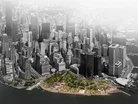Stantec to lead design on $129mn coastal resilience project for Manhattan

Stantec has been selected by the New York City Economic Development Corporation (NYCEDC) to lead design for the Battery Coastal Resilience Project, spanning one third of a mile of waterfront along Manhattan’s 25-acre Battery Park.
The project is one of several underway or in planning as part of the City’s Lower Manhattan Coastal Resiliency initiative focused on protecting Lower Manhattan from the impacts of rising sea levels caused by climate change.
As part of the 4-year, $129mn project, Stantec will lead design plans for a reconstructed wharf at the southern tip of Manhattan that will raise the waterfront esplanade approximately 5 feet above its current elevation - 11 feet above Mean Sea Level - to protect the park and nearby community, as the Battery currently sits at an elevation that will be submerged as sea levels rise.
The project will ensure usability of this iconic public space for millions of yearly visitors over the next 80 years and play a critical role in Lower Manhattan’s growing network of resiliency reinforcements.
“Current sea level rise projections show that the Battery sits in a particularly vulnerable location and needed wharf reconstruction provides a timely opportunity to protect the Battery’s unique character and usability for years to come,” said Brian O’Donnell, Principal-in-Charge, Stantec.
SEE ALSO:
Vinci to build $190mn water treatment plant in Phnom Penh
Skanska selected to complete $76mn rehabilitation of Manhattan Bridge
Sydney Water appoints D4C as regional delivery contractor
Read the latest issue of Construction Global here
Several complex issues will be addressed in the design, including in-water construction, interior drainage, and integration of a new wharf elevation with the existing parkland. The project team anticipates using an adaptive design strategy – one that will continue to provide the well-known views of the New York harbour, relief from sea level rise and nuisance flooding, and flexibility for uncertain future conditions. Resilient planting will also be critical in ensuring survivability from major storms while establishing a lush and peaceful setting.
“Increases in extreme weather events are bringing resiliency to the top of city agendas across the world,” said Gary Sorge,Stantec’s Discipline Leader for Landscape Architecture. “Stantec is in a strong position to meet those needs and has been bringing forward both green and grey infrastructure solutions that will protect the drivers of our economies – our cities. It takes a truly interdisciplinary approach to make communities both resilient and liveable for future generations.”
The interdisciplinary design will be led out of Stantec’s New York City office, which counts more than 300 professionals, and will include landscape architecture, waterfront engineering, and environmental review, with the support of several specialty contractors. Design is expected to take 18 months.



